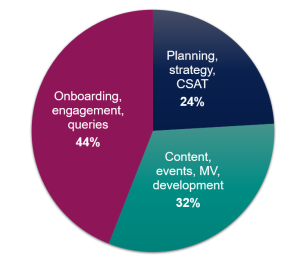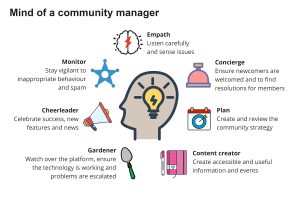We ran a survey with our internal community managers to understand how they spend their time and what leads to success.
Why we love building community.
Our education and research communities are a lifeline for thousands of professionals. They create spaces for people to connect, learn and support each other covering different topics around the sector and institution’s needs. But a community does not happen on its own. Building them takes the focus and time of a devoted community manager.
The survey
To find out more, we created a survey divided into three types of tasks: annual, monthly, and weekly. This would help paint a picture of how long community managers spend on different things from strategic planning, hosting events to responding to technical queries.
Community is growing as more people recognise their power. When we set realistic expectations of what is involved, we lay foundations for successful and engaged spaces that help everyone.
The findings
On average, our community managers spend 6 days per month ontheir community activity (1.4 days per week).
Regular engagement tasks take the most time to complete, activities like onboarding, responding to posts and technical queries. Monthly tasks like creating content, event management and personal development, take 32% of time. And lastly, yearly tasks like community planning including creating a strategy, organising satisfaction surveys, and doing research take 24%.

Community managers are superheroes. Diligently responding to the community’s needs and finding new ways to engage with their audience. We recently updated our mind of a community manager to reflect each characteristic. They include, being a concierge making sure newcomers feel welcome. Sense checking the community and listening carefully to needs. Staying vigilant to inappropriate behaviour and celebrating success while watching over the platform.

A recipe for success
So, what else does a successful community need? From looking at our successful communities, as well as a committed community manager, we identified 10 key building blocks.
- The manager creates the community from a genuine need, creating value for everyone involved.
- It has a unique proposition, offering something different to what might already exist.
- A strong purpose with clear objectives, and tactics.
- Engaged community manager(s) and support staff to help drive activity.
- Awareness – people know the community exists.
- Builds connections between members that improves trust.
- Meets member expectations.
- Can adapt to change.
- Uses the right technology.
- Has multiple touchpoints to connect (especially important if there are barriers to using the tech).
What did we learn?
The survey and our research confirm that community is complex but the benefits are worth all the effort.
- There is no typical day in a community. Regardless of how much you plan, community work is reactive as priorities and needs change.
- The time spent on planning does not increase when the community size increases.
- The time spent on moderation, relationships, can increase.
- Smaller communities can still spend considerable time initiating discussions and building relationships. In a larger community, this might trade-off to managing volunteers instead.
We see the most success when the community is created with its audience at the heart of every decision.
Want to find out more? Learn about our communities and get involved.
Looking for support? We would love to connect with you and find out more. Let us know about what your education or research community is doing.


One reply on “Building our communities: what is really involved and why do we love them?”
Great post – thankyou Carolina!